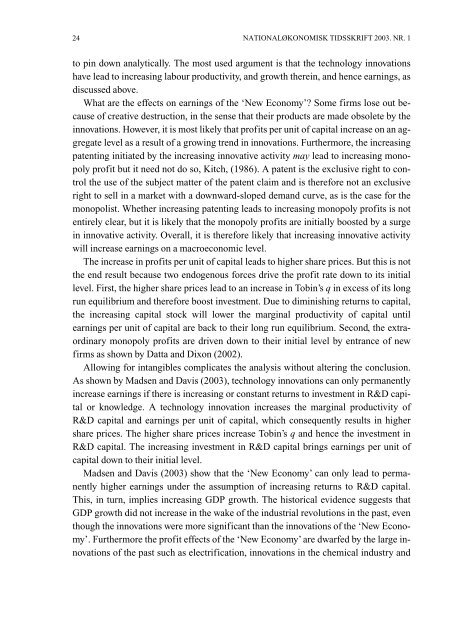samlet årgang - Økonomisk Institut - Københavns Universitet
samlet årgang - Økonomisk Institut - Københavns Universitet
samlet årgang - Økonomisk Institut - Københavns Universitet
You also want an ePaper? Increase the reach of your titles
YUMPU automatically turns print PDFs into web optimized ePapers that Google loves.
24<br />
NATIONALØKONOMISK TIDSSKRIFT 2003. NR. 1<br />
to pin down analytically. The most used argument is that the technology innovations<br />
have lead to increasing labour productivity, and growth therein, and hence earnings, as<br />
discussed above.<br />
What are the effects on earnings of the ‘New Economy’? Some firms lose out because<br />
of creative destruction, in the sense that their products are made obsolete by the<br />
innovations. However, it is most likely that profits per unit of capital increase on an aggregate<br />
level as a result of a growing trend in innovations. Furthermore, the increasing<br />
patenting initiated by the increasing innovative activity may lead to increasing monopoly<br />
profit but it need not do so, Kitch, (1986). A patent is the exclusive right to control<br />
the use of the subject matter of the patent claim and is therefore not an exclusive<br />
right to sell in a market with a downward-sloped demand curve, as is the case for the<br />
monopolist. Whether increasing patenting leads to increasing monopoly profits is not<br />
entirely clear, but it is likely that the monopoly profits are initially boosted by a surge<br />
in innovative activity. Overall, it is therefore likely that increasing innovative activity<br />
will increase earnings on a macroeconomic level.<br />
The increase in profits per unit of capital leads to higher share prices. But this is not<br />
the end result because two endogenous forces drive the profit rate down to its initial<br />
level. First, the higher share prices lead to an increase in Tobin’s q in excess of its long<br />
run equilibrium and therefore boost investment. Due to diminishing returns to capital,<br />
the increasing capital stock will lower the marginal productivity of capital until<br />
earnings per unit of capital are back to their long run equilibrium. Second, the extra -<br />
ordinary monopoly profits are driven down to their initial level by entrance of new<br />
firms as shown by Datta and Dixon (2002).<br />
Allowing for intangibles complicates the analysis without altering the conclusion.<br />
As shown by Madsen and Davis (2003), technology innovations can only permanently<br />
increase earnings if there is increasing or constant returns to investment in R&D capital<br />
or knowledge. A technology innovation increases the marginal productivity of<br />
R&D capital and earnings per unit of capital, which consequently results in higher<br />
share prices. The higher share prices increase Tobin’s q and hence the investment in<br />
R&D capital. The increasing investment in R&D capital brings earnings per unit of<br />
capital down to their initial level.<br />
Madsen and Davis (2003) show that the ‘New Economy’ can only lead to permanently<br />
higher earnings under the assumption of increasing returns to R&D capital.<br />
This, in turn, implies increasing GDP growth. The historical evidence suggests that<br />
GDP growth did not increase in the wake of the industrial revolutions in the past, even<br />
though the innovations were more significant than the innovations of the ‘New Economy’.<br />
Furthermore the profit effects of the ‘New Economy’ are dwarfed by the large innovations<br />
of the past such as electrification, innovations in the chemical industry and

















